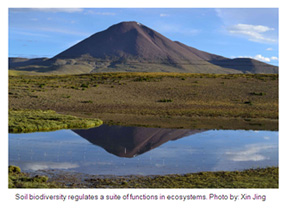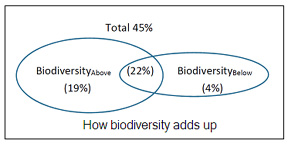Conducting the ecological choir
Below-ground biodiversity is found to be important in how the ecology responds to climate change, , says S.Ananthanarayanan.
Biodiversity is now recognised as a vital factor in the resilience of the environment. The nine ‘planetary boundaries’, or the limits within which the world would have to stay to avoid irreversible environmental damage, developed by the Stockholm Resilience
Centre in 2009, listed the loss of biodiversity as one, along with climate change, chemical pollution and land use.
Biodiversity, however, has been understood more in terms of the plant and animal species in forests and grasslands and even in agriculture and aquaculture. A paper in the journal, Nature Communications, now turns the focus on lesser studied variety of
life forms to be found underground and within the soil. Xin Jing, Yu Shi, Haiyan Chu, Ke Zhao, Litong Chen, Yue Shi, Youxu Jiang and Jin-Sheng He from the University of Peking and the Chinese Academy of Sciences at Nanjing, Xining and Beijing and Nathan J.
Sanders and Aimée T. Classen from the University of Copenhagen report that soil bacteria and below-ground plant and animal species form an important part of a complex that regulates relations between parts of the ecosystem and how it responds to climate change.

Although there is debate regarding the mechanism of the action of biodiversity, the fact that a variety of species living together makes for stability and efficient recycling of resources in an ecosystem is understood with some clarity. The studies, however,
have been in the form of measuring the productivity, for instance, of a group of plants when grown either together or separately, in small plots, to demonstrate the value of diversity. But an ecosystem is seen as consisting of several, different, inter-related
functions, a property that is termed ecosystem multifunctionality, or EMF, and studies have shown that the EMF is dependent, even more than individual functions, on biodiversity, or the presence of a variety of species.
Within biodiversity, however, analysis and separation of the effect of variety of species either above or below ground, has not been possible, the paper in Nature Communications says, perhaps because of the great complexity and variability underground, even
within a short distance.

“….pick up a handful of soil and you might find more species there than all of the vertebrates on the planet,” says co-author, Aimée T. Classen, from the Centre for Macroecology, Evolution and Climate, University of Copenhagen, in a news release from the
University. The study, in fact, cites an 1881 paper, ‘The Formation of Vegetable Mould, Through the Action of Worms, with Observations on Their Habits,’ by Charles Darwin, to illustrate that the diversity and importance of underground species has been long
recognised.
There have also been a number of investigations, the study says, of the effect that climate has on the constituents of an ecosystem, like the plants, animals, earthworms, microbes and hence the composition of biotic communities. There have even been studies
that combine variations of climate with different levels of biodiversity to see how these affect different things, like the productivity or resilience and the way the whole, integrated ecosystem works. The studies have made use of changes in climatic conditions
as one moves over a landscape, and also the changes in the kind of vegetation, but mainly the over-ground plant cover. Carrying out a study of how changing geographic, climatic and also the biodiversity, both above and below ground, affect the ecology, would
help identify and quantify the effect of different components, the Nature Communications paper says.

The study here reported hence covered sixty sites spanning a gradual variation of climate along alpine grasslands on the Tibetan plateau, spread over nearly 1,000 km, to examine how the EMF, the combined ‘suite’ of environmental functions, behaved under
different levels of climate as well as biodiversity, both above and below-ground. For quantification of multifunctionality, eight key ecosystem features: (1) over-ground biomass, (2) root biomass, (3) soil organic carbon, (4) soil nitrogen, (5) soil available
nitrogen, (6) soil phosphorus, (7) plant nitrogen (nitrogen pools in aboveground biomass), and (8) plant phosphorus (phosphorus pools in aboveground biomass), were estimated at each of the sixty sites and averaged. As for the levels of biodiversity at the
same sites, estimates were made of the different kinds of (1) bacteria in the soil, (2) another variety of living cells called archaea, (3) of other animal life in the soil, (4) of fungi in the soil and (5) plant species, to compute a ‘soil biodiversity index’.
The method used to count the kinds of soil organisms was by analysis of DNA extracted from soil samples.

The levels of multifunctionality in the various sites, as the five elements and the combined index of biodiversity increased or fell, were then analysed statistically. The levels of EMF can be seen to increase with increase in diversity in soil bacteria
and fauna, and total soil biodiversity, while diversity in fungi and archaea do not seem to have an effect.
Non-biotic influences were also assessed by relating EMF levels with rainfall, temperature and the soil content of moisture, acidity and calcium carbonate (limestone or chalk). On further statistical analysis, it is found that the strongest single driver
of EMF is soil moisture.
Plant species richness and below-ground biodiversity are seen to have about equal effect and the two factors, taken together, accounted for a large fraction, about 45%, of the variation in EMF across sites. The finding, overall, is that non-biotic conditions,
of rainfall, moisture and soil chemistry influence the effects of biodiversity, which in turn, mediate the effect of non-biotic conditions on EMF.

The study represents investigation into how different condition affect the way an ecosystem responds to climate change. The findings suggest ways of influencing levels and nature of the components of the ecosystem to help the system adapt to changing conditions,
the study says. A significant finding, for instance, was that soil biodiversity may have stronger effects on ecosystem in areas of higher rainfall. “That is important because scientific studies often focus on temperature – not precipitation – when predicting
how ecosystems will respond to future changes such as climate change”, Aimée Classen said. ……As climates change and species are lost and gained from ecosystems, predicting how ecosystems will function in the future will require experiments and observations
that link biodiversity above and below ground to EMF,” the paper says.
The writer can be contacted at response@simplescience.in